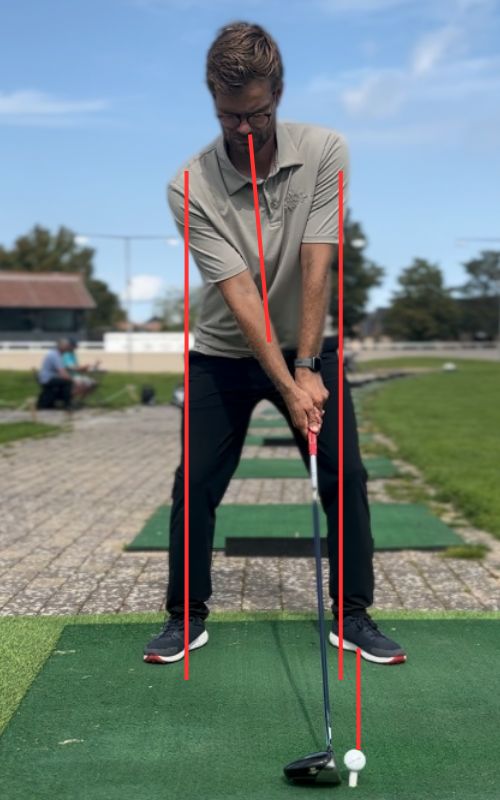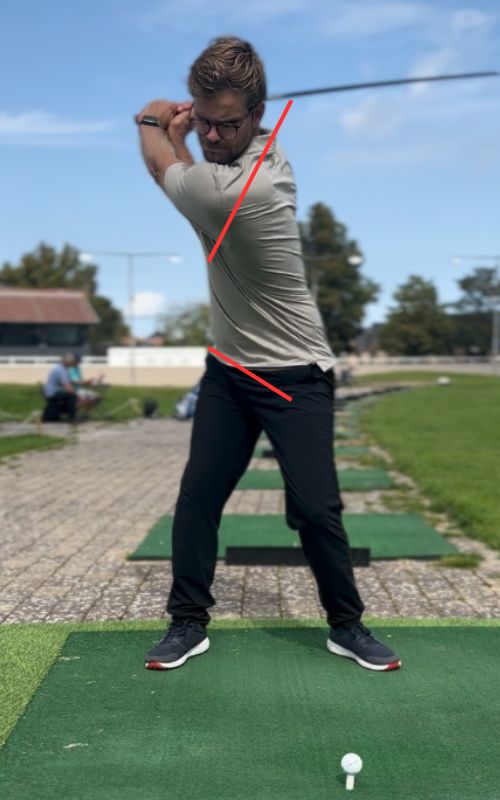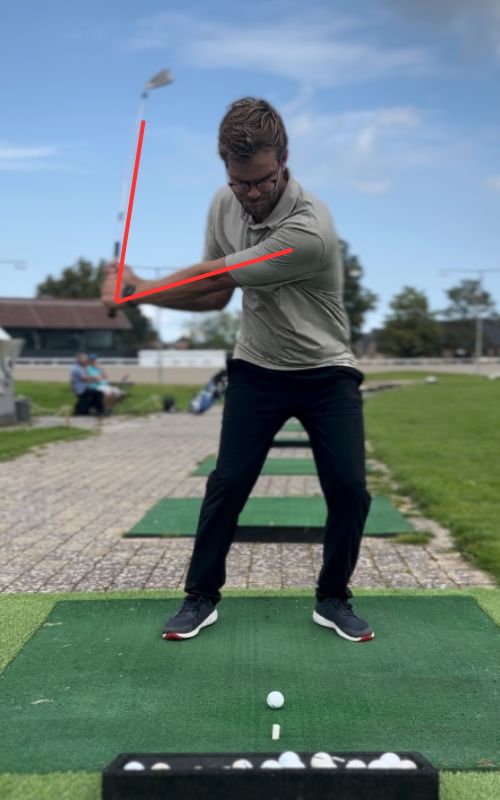
5 Simple Tips on How to Hit a Golf Ball Further
- Home / Beginners Guide /
- 5 Simple Tips on How to Hit a Golf Ball Further

5 Simple Tips on How to Hit a Golf Ball Further
5 Simple Tips on How to Hit a Golf Ball Further
Unleash Your Swing and learn How to Hit a Golf Ball Further
Welcome to Golf For Beginners Academy, where we’re about to unravel the secrets of How to Hit a Golf Ball Farther! Ready to maximizing your distance off the tee. In this guide, we’ll explore five straightforward yet highly effective tips on how to hit a golf ball further. Let’s power up your swing!
What you will learn (Table of Contents)
Toggle1 - Optimize Your Stance for Power
Before you embark on the journey to unlock more power in your golf shots, it’s essential to establish a rock-solid foundation through the optimization of your stance. In this section, we’ll delve into the intricacies of achieving the ideal golf stance, emphasizing balance, weight distribution, and the critical role it plays in generating power and stability in your swing.
The Significance of a Proper Stance: Your golf stance serves as the launchpad for your swing, and its correct configuration is paramount to harnessing maximum power. By optimizing your stance, you set the stage for a dynamic and efficient golf swing. Let’s break down the key elements that contribute to an effective stance.
Shoulder-Width Foundation: Begin by positioning your feet at shoulder width apart. This stance width provides a stable base and balance, ensuring you can maintain control throughout your swing. Visualize your stance as the bedrock upon which your golf swing masterpiece will be built.
Even Weight Distribution: Once you’ve established your shoulder-width foundation, distribute your weight evenly between both feet. Balance is key to a powerful and controlled swing. Avoid favoring one side or the other, as it can lead to instability and inconsistent shots. Think of your stance as a perfectly balanced scale, ready to weigh in on the power equation.
Knee Flexion for Dynamic Power: Slightly flex your knees to add an element of dynamic power to your stance. This knee flexion serves as a coiled spring, ready to release energy during your downswing. Imagine the potential energy stored in your legs, waiting to be converted into clubhead speed and distance.
Spine Tilt for Optimal Alignment: To complete your stance optimization, tilt your spine away from the target ever so slightly. This slight tilt helps align your body correctly and prepares your shoulders for a powerful coil during the backswing. Visualize your spine as the axis around which your swing will rotate, enabling you to generate torque and power.
Stability and Balance: As you adopt this balanced and optimized stance, focus on maintaining stability and balance throughout your swing. Keep your weight centered, your knees flexed, and your spine tilted. These elements work in harmony to provide a stable and powerful foundation for your golf swing.
Practice and Consistency: Achieving a proper stance requires practice and consistency. Spend time at the driving range honing your stance, ensuring it becomes second nature.
In conclusion, optimizing your stance is the foundational step in your journey to unlocking maximum power in your golf shots. Think of it as the canvas upon which you’ll paint your golfing masterpiece. Embrace the principles of shoulder-width foundation, even weight distribution, knee flexion, and spine tilt. With the right stance, you’ll experience a more powerful and stable swing, translating into longer and more controlled shots on the golf course.

2 - Master the Hip Rotation
Achieving maximum distance in your golf shots goes beyond upper body strength; it involves mastering the art of hip rotation. In this section, we will explore the critical role hip engagement plays in transferring energy and increasing clubhead speed, helping you unleash the full potential of your swing.
Understanding the Importance of Hip Rotation: Hip rotation is a fundamental component of generating power in your golf swing. When you initiate your downswing, it’s essential to allow your hips to rotate smoothly. This rotational movement acts as a powerhouse, transferring energy from your lower body to the club. Think of your hips as the engine driving your swing, and mastering this aspect will lead to increased clubhead speed and, consequently, longer shots.
Initiating the Downswing: The proper sequence of your swing involves the hips initiating the downswing. As you transition from the backswing to the downswing, focus on starting the movement with your hips. This rotational action sets the tone for the rest of your swing and ensures that you harness the energy generated by your lower body effectively.
Hip Rotation Dynamics: Effective hip rotation is not about simply turning your hips; it’s about achieving a balanced and synchronized movement. Ensure that your hip rotation is gradual and controlled, avoiding any jerky or forced movements. Visualize a smooth pivot around your spine, allowing your hips to lead the way and follow through seamlessly.
Maintaining Posture and Balance: While emphasizing hip rotation, it’s crucial to maintain proper posture and balance throughout your swing. Keep your spine relatively straight and your weight evenly distributed between your feet. This stability allows you to control the rotational forces generated by your hips and channel them into your clubhead speed. Balance is the key to accuracy and control, which are essential in addition to distance.
The Role of Core Strength: Developing core strength is vital for optimizing hip rotation. A strong core provides stability and control during your swing, allowing you to harness the energy generated by your hips more effectively. Incorporate core-strengthening exercises into your fitness routine to enhance your overall golf performance.
In conclusion, mastering hip rotation is a pivotal aspect of unlocking explosive power in your golf swing. Embrace the concept of your hips as the engine driving your swing’s energy. Practice gradual, controlled hip rotation to ensure a balanced and synchronized movement. With proper hip engagement, you’ll experience increased clubhead speed, leading to longer and more powerful golf shots.

3 - Generate Lag with Wrist Action
Creating and harnessing lag in your golf swing is a secret weapon for adding significant distance to your shots. In this section, we’ll delve into the intricacies of wrist action, teaching you how to generate and maintain lag effectively for a more powerful and controlled downswing.
The Art of Lag Creation: Lag refers to the angle formed between the clubshaft and your lead forearm during the downswing. To generate lag, initiate your swing with a slight wrist hinge during the backswing. This hinge allows you to store energy like a coiled spring, ready to be unleashed for explosive impact. Think of it as winding up before delivering a powerful punch. The key is to maintain this wrist hinge until the last possible moment in your downswing.
Timing is Everything: One of the critical aspects of lag creation is the timing of your wrist release. Delay releasing your wrists until the very last moment before impact. This delayed release is what makes lag such a potent force in your swing. As you transition from the top of your backswing to the downswing, maintain that angle between your clubshaft and forearm, resisting the urge to prematurely release your wrists. Picture it as holding back a loaded slingshot, with the clubhead as your projectile.
Storage and Release of Energy: The beauty of lag lies in its ability to store and release energy explosively. As you maintain the hinge in your wrists, you’re storing potential energy that can be transferred to the golf ball at impact. When you finally release your wrists, that stored energy is unleashed, resulting in faster clubhead speed and greater distance. It’s akin to snapping a whip—a controlled and powerful release that propels the ball down the fairway with added velocity.
Practice and Patience: Developing the skill of generating lag with wrist action requires practice and patience. Start by working on your wrist hinge during your backswing, ensuring it’s gradual and not forced. Progress to your downswing, concentrating on delaying the release. Use practice drills and swing aids to reinforce this skill. It’s essential to strike a balance between generating lag and maintaining control, so practice is key to refining your technique.
Seeking Professional Guidance: For a more in-depth understanding of generating lag, consider seeking guidance from a golf instructor. They can provide personalized feedback, drills, and exercises to help you master this crucial aspect of your swing. Additionally, video analysis can offer valuable insights into your wrist action, enabling you to make necessary adjustments.
In conclusion, generating and maintaining lag with wrist action can significantly enhance your golf swing’s power and distance potential. Embrace the concept of lag as a way to store and release energy explosively at impact. Remember that perfecting this skill takes time and dedication, but the rewards in terms of longer and more controlled shots are well worth the effort.

4 - Perfect Your Timing and Tempo
Mastering the art of hitting a golf ball further goes beyond sheer power; it hinges on achieving the perfect blend of timing and tempo. Let’s dive deep into this crucial aspect of your swing, exploring techniques to help you harness your full potential for longer shots.
The Art of Controlled Tempo: As a beginner, it’s tempting to swing forcefully, believing that raw power alone will send the ball soaring. However, the truth lies in controlling your tempo. Rushing the downswing often leads to inconsistencies and shorter drives. Instead, focus on a smooth, well-timed transition between your backswing and downswing. Imagine a pendulum, swinging back and forth with a balanced rhythm. This analogy reflects the controlled tempo you should aim for in your golf swing.
Balance and Rhythm: Achieving the perfect tempo involves maintaining balance throughout your swing. A proper weight shift from your back foot to your front foot is crucial. Visualize the transfer of your weight, like a graceful dance move, ensuring you maintain your center of gravity and rhythm. This balanced, rhythmic motion is the key to unlocking your optimal clubhead speed, which directly translates into those coveted longer drives.
Mental Game: Your mental approach plays a significant role in mastering timing and tempo. Stay relaxed and focused during your swing, free from any unnecessary tension or anxiety. Practice mindfulness and visualization techniques to enhance your mental game. Visualize the ideal swing in your mind before stepping up to the ball, reinforcing the importance of a controlled and smooth tempo in your subconscious.
Practice and Patience: Achieving a consistent and controlled tempo takes practice and patience. Dedicate time to the driving range to work on your swing mechanics. Consider seeking guidance from a golf instructor to fine-tune your tempo. Understand that it’s a gradual process, and improvements will come with dedication and repetition.
5 - Choose the Right Equipment
The right equipment can be your secret weapon for hitting a golf ball further. Selecting the appropriate gear tailored to your unique swing characteristics is crucial. In this section, we’ll explore the nuances of golf equipment selection and custom fitting, unveiling the key to unlocking your distance potential.
Driver Loft and Shaft Flex: Your driver plays a pivotal role in maximizing distance off the tee. To optimize your drives, ensure your driver has the appropriate loft and shaft flex for your swing speed. A higher loft is ideal for slower swing speeds, as it imparts more backspin and lift on the ball, helping it stay in the air longer. Conversely, if you possess a faster swing speed, a lower loft can help reduce spin for added distance. The shaft flex should match your swing tempo and strength. A more flexible shaft can generate more clubhead speed for those with slower tempos, while a stiffer shaft suits faster swingers. Custom fitting your driver, under the guidance of a professional, can fine-tune these critical aspects to suit your game perfectly.
Club Custom Fitting: Custom fitting is a game-changer when it comes to optimizing your distance potential. It involves tailoring your clubs to match your unique swing characteristics, body posture, and physical attributes. A custom fitting session typically assesses factors such as club length, lie angle, grip size, and more. This meticulous process ensures that each club in your bag complements your swing, resulting in improved accuracy and distance. Many golf retailers and professionals offer custom fitting services, providing you with the opportunity to invest in equipment that truly suits your game.
Ball Selection: Don’t underestimate the role of the golf ball in maximizing your distance. Different golf balls offer varying levels of spin and compression. Consider experimenting with different ball types to find the one that aligns with your swing speed and desired ball flight. A golf ball that matches your game can significantly impact your shot distance and overall performance.
In conclusion, selecting the right equipment and custom fitting your clubs are integral components of hitting a golf ball farther. Pay meticulous attention to your driver’s loft and shaft flex, explore the benefits of club custom fitting, and experiment with different golf balls. By fine-tuning your gear to match your unique characteristics, you’ll unlock your full potential for maximum distance on the golf course.
Want to learn more about how to play golf? ⛳️
If you’re eager to dive deeper into golf’s intriguing world and master the ins and outs of the game, look no further than our “Golf For Beginners – The Ultimate Starter Guide.” Whether you’re a newbie or just brushing up on your skills, this online course has something for everyone.
⛳️ Discover the Ultimate Golf Starter Guide Right Here ⛳️
Conclusion on How to Hit a Golf Ball Further for Beginners
Hitting the ball far can be exhilarating, but is it essential for beginner golfers? While distance is a valuable asset, focus on mastering fundamental techniques first. As your skills grow, incorporate these tips gradually. Remember, accuracy and consistency trump sheer power for beginners. Enjoy the journey of improvement and the occasional long drive will become an added bonus to your game. Stay tuned to Golf For Beginners Academy for more valuable insights to enhance your golfing journey. Happy swinging!
Did you like the article "How to Hit a Golf Ball Further"?
If you want more detailed help with you game of golf, and specifically about the short game of golf, our partner-portal called World Of Short Game deliver great content for all short game related topics. Click here to visit World Of Short Game.
And if you live in Denmark, never hesitated to reach out to Danish Golf Academy for help with any part of your game.
golfforbeginners
Recent Comments
Copyright @ 2024 - Golf For Beginners Academy
